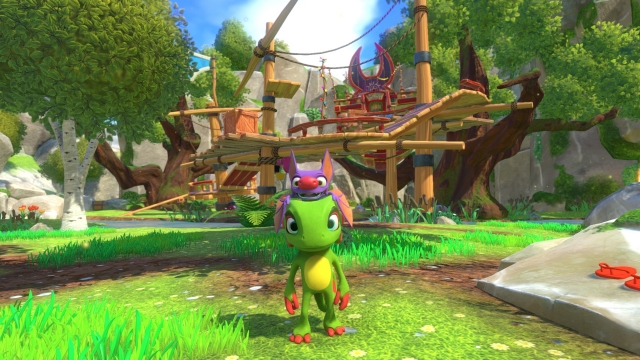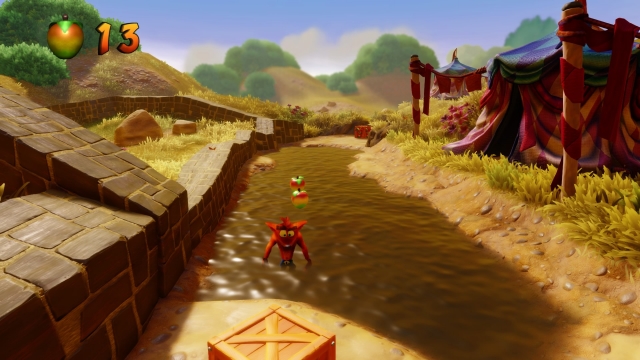
Crash and Spyro: Should They Return With New Releases?
If you played videogames on consoles in any capacity in the mid- to late Nineties, there’s an inordinately high chance that you’ve played at least one 3D platformer. This was an era in which the genre was the undisputed king of the industry, long before first-person shooters truly came into their own on consoles and every studio under the sun was feverishly attempting to release the “Halo killer”. No, rewind 20 years or so and game developers were aping what Nintendo had introduced to the gaming world when it released Super Mario 64. The cavalcade of mascot-driven platformers and countless licenced tie-ins was nothing out of the ordinary, of course; but with the launch of the Nintendo 64 and Sony PlayStation (and, I suppose, the Sega Saturn to some extent), consumers expected games with fully realised 3D worlds to explore. 2D was perceived as being outdated, old hat, archaic; gamers wanted experiences that pushed this new, more powerful hardware to its limits and 2D wasn’t seen as the way forward in many people’s eyes.
Of course, as with anything in the games industry, this chasing of the proverbial golden goose was met with varying degrees of success. Some developers, such as Naughty Dog, Insomniac Games and Rare positively thrived during this period. Indeed, the latter’s output during the N64 era is widely regarded as that studio’s best work and certainly the most fondly remembered by fans. Comparatively, the work Insomniac and Naughty Dog did on Spyro the Dragon and Crash Bandicoot respectively is also thought of by many as among the pinnacle of what 3D platformers of the time had to offer. On the flipside, the less said about Sonic the Hedgehog’s transition from 2D to 3D the better, and there were hundreds of titles across the consoles of the time that were shameless cash-ins on whatever licences were popular. If a film or TV show came out, you could absolutely bet your life that a hastily cobbled together officially licenced videogame tie-in would accompany its release.

Mario's transition from 2D to 3D saw every developer under the sun scrambling to ape Super Mario 64's success.
Through the early to mid-2000’s, the genre persisted, although its popularity and stranglehold on the industry did begin to wane. By the time the Xbox 360 and PlayStation 3 were on store shelves, even the studios who had for years been at the forefront of the platformer craze either half-heartedly clung on or abandoned the genre entirely. This was seemingly to cater to “more mature” audiences, (striving for more realistic visuals and pursuing movie-like storytelling), especially those developers commonly associated with Sony. Insomniac released the Resistance trilogy of FPS’s while still churning out Ratchet & Clank titles of varying quality. Sucker Punch, who’d previously worked on the Sly Cooper trilogy for PlayStation 2, went on to create inFamous. Likewise, Naughty Dog moved on entirely from Crash Bandicoot and Jak & Daxter to concentrate on Uncharted and The Last of Us. Flash forward to the present day and even the dependable onslaught of shoddy licenced tie-in platformers has dried up on consoles, as the mobile phone market proved to be a fantastic source of income for anyone who’d snagged the licence to something and was looking to make a quick buck.
Of course, anyone who follows videogames closely knows that 2D platformers made a comeback in a big way after the coming of the indie development scene with releases such as Cave Story, Super Meat Boy and Braid foreshadowing what would be a seismic shift in the industry. Just a cursory glance at the Nintendo Switch eShop, for example, provides a candid look at how the balance between AAA and indie development has shifted, how the general tastes and preferences of consumers have evolved and how big a factor nostalgia is nowadays. The 2D platformer renaissance also paved the way for 3D platformers to make something of a return, with nostalgia again playing a key role. Never was this more evident than when Playtonic Games, a studio primarily comprised of ex-Rare employees, made waves with the announcement of Yooka-Laylee, a game they billed as the spiritual successor to two of their N64 platformers, Banjo-Kazooie and Banjo-Tooie. Yooka-Laylee garnered a huge amount of support when its Kickstarter campaign launched. Its initial £175,000 funding goal was reached in a record breaking 40 minutes and by the time the funding campaign ended, Playtonic had received well in excess of £2,000,000 from backers. It’s clear that the gamers - myself included - who had grown up in the heyday of the 2D and 3D platformers were eager to re-experience the genres they’d spent so many hours enjoying as kids.

Playtonic's crowdfunding campaign for Yooka-Laylee promised nostalgic fans of Rare's work on the top 3D platformers of the N64 a return of the genre.
Nostalgia for the games of yesteryear has also sparked a massive surge of re-releases. This generation of consoles in particular has seen an extraordinary amount of remastered titles and full on remakes see the light of day. In the last year and a half, two of the most high-profile repackagings of older titles have come from Activision: Crash Bandicoot: N.Sane Trilogy and Spyro: Reignited Trilogy, developed by Vicarious Visions and Toys for Bob respectively, both titles bundling together their franchise’s PlayStation era releases and presenting them to audiences both new and old with modern production values.
Which brings us to the focus of this article: should Crash and Spyro return with fresh entries in their respective franchises?
The commercial successes of both N.Sane Trilogy and Reignited Trilogy certainly make a case for why their namesakes should return in some form in the future. However, it is important to note why these characters faded into the background in the first place. As mentioned earlier in this article, the general shift from more family friendly experiences in the pursuit of photorealism and mature storytelling certainly played a part in why characters such as Crash and Spyro faded out of the public’s consciousness, but let’s also not forget that post-PlayStation, neither of these two former powerhouses of gaming fared well critically either. Both franchises were bounced around between various developers churning out entries that were regarded as either gimmicky or generally uninspired for years prior to the Vivendi/Activision merger in 2008, at which point Crash more or less faded into obscurity entirely while Spyro was relegated to being a bit player in the Skylanders series.

From headliner to voiceless ensemble member, Spyro's fall from grace was at least a few steps above how Crash faded from the public mind.
It was the persistent nagging of vocal fans wondering when or if Crash would ever return that prompted Activision to sate their audience’s hunger with N.Sane Trilogy, while that title’s phenomenal sales figures and those same fans’ desire to see Spyro receive the same treatment led to Reignited Trilogy’s release. However, having played through the entirety of N.Sane Trilogy in 2017 and currently working my way through Reignited Trilogy, I have doubts about whether or not either Crash or Spyro would fare well should they return with all-new releases. Now, don’t get me wrong: both trilogies do an impeccable job of preserving the gameplay of the original releases while simultaneously refurbishing them so that they’re more in line with today’s AAA titles in terms of production values. Not to sound disparaging of the work that Vicarious Visions and Toys for Bob did, but both sets of re-releases feel of their time.
The platforming in Crash’s trilogy feels floaty and imprecise, for example; this coupled with the hitbox in his debut game being oval (instead of square, as is the case in the two sequels) makes some of the trickier platforming sequences incredibly frustrating, as all too often I thought I’d made a successful jump only to slide off my intended destination once I’d landed. Furthermore, Crash’s camera angles also don’t gel well with what the games ask of you at times. Having to move from side to side while competing with slippery mechanics is one thing, but when one of the many sequences in which you’re running away from or toward the camera rears its head and you’re unable to effectively judge the distance you need to jump, Crash goes from frustrating to downright infuriating.
Spyro’s trilogy fares far better, in my opinion. He controls far tighter than Crash does, while the camera poses less of a problem when attempting to navigate through the worlds. That being said, the emphasis on collecting endless amounts of trinkets and gems mars the experience of the Spyro trilogy somewhat, for me anyway. Crash, for its faults, at least presents players with a more focused approach to platforming, where the challenge is merely to get from point A to point B. Spyro on the other hand is more content with minimising the platforming aspects in favour of having the player scour every inch of its levels for hundreds upon thousands of bits and pieces that all too often feel superfluous. Don’t get me wrong, it’s still fun and infinitely more playable than Crash’s games are, but the endless collecting gets tedious for me after a while in the same way that Yooka-Laylee lost my interest after a relatively short time (but at least Spyro controls well, which is one thing it has over Yooka-Laylee).

They might be prettier, but N.Sane Trilogy and Reignited Trilogy retain their late 90's quirks.
So, the question still remains: should Crash and Spyro return with new releases? As far as I’m concerned, yes, they absolutely should. Both series are fun in their own way and have their different merits and areas in which they excel and I for one would happily play another entry in either series. However, it won’t be enough to merely take the gameplay and mechanics of N.Sane Trilogy and Reignited Trilogy, come up with some new levels and call it a day. These trilogies accomplished what Activision set out to do: feed into the nostalgia of those who played the games when they originally released while revamping them to look and sound like how we all saw them in our mind’s eye two decades ago. And for that, nobody can fault them; they did a fantastic job. But should Activision call on Vicarious Visions and Toys for Bob to develop new entries, the shortcomings of both franchises need to be addressed. Crash can’t slip and slide off platforms while the camera feels like it’s actively working against the player and Spyro can’t expect the player to aimlessly wander around searching high and low for seemingly pointless nicknacks. If both series can eschew those trappings of old fashioned game design and return with updated gameplay mechanics and fresh ideas, I’ll be more than happy to give both of them a whirl.









COMMENTS